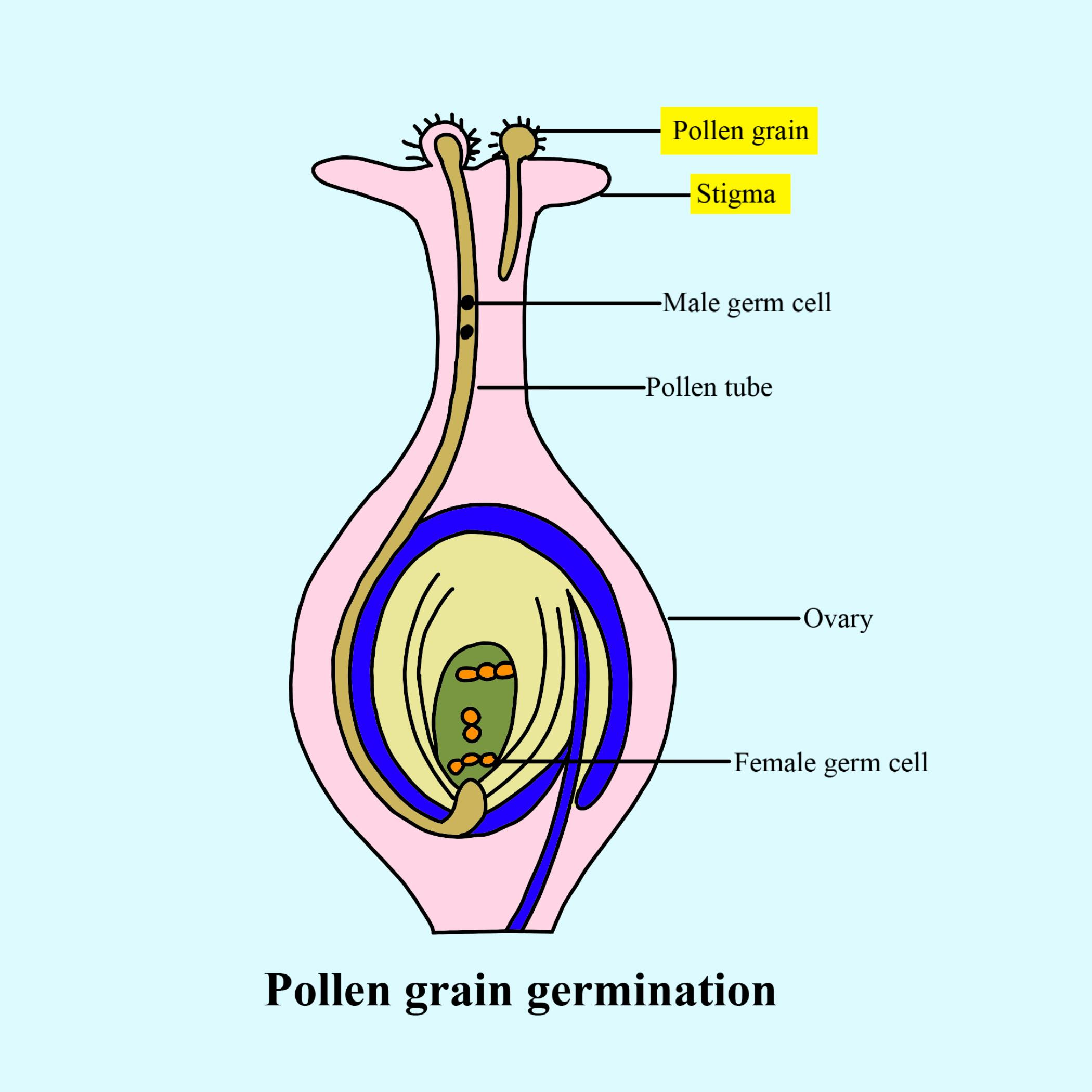
Draw the diagram showing the germination of pollen on stigma and label the following parts
(i) Stigma
(ii) Pollen tube
Answer
548.4k+ views
Hint: Pollination and fertilization are the two main steps of sexual reproduction in a flowering plant. The pollen grains from another plant and sometimes even from the same plant, comes and sticks to the stigma of the flower and germinates to form a pollen tube.
Complete answer:
Below is the diagram of germination of pollen on stigma:

Here the long pipe-shaped structure is the pollen tube. The stigma is the uppermost part of the pistil where pollen grains stick after pollination.
Additional Information: The germination of a pollen grain starts when the pollen grain lands on the stigma. In flowering plants, the stigma and ovary are connected through a hollow structure named style. On the stigma, the pollen grains absorb water and nutrients and produce a tiny pollen tube that passes through the style and reaches the ovary. Then enlargement of the tube cell occurs which comes out of the pollen grain through a germ pore to form the pollen tube. The tube nucleus comes to the tip of the pollen tube. After that, the generative cell also passes into it and soon divides into two male gametes. In the case of double fertilization, the pollen tube fuses with the egg cell and the other cell combines with the two subsidiary Sexual nuclei of the ovule. The fusion of egg cells with tube cells makes the development of an embryo possible whereas the fusion of nuclei and other cells initiates the formation of the endosperm. The ovule, later on, transforms into a seed.
Note: The phenomenon by which the pollen grain reaches the stigma of the pistil is in fact known as pollination and is occurred by biotic or abiotic factors. Biotic factors can be animals like insects, birds, bats, or even mammals and humans. It is a very important process for fertilization to occur.
Complete answer:
Below is the diagram of germination of pollen on stigma:

Here the long pipe-shaped structure is the pollen tube. The stigma is the uppermost part of the pistil where pollen grains stick after pollination.
Additional Information: The germination of a pollen grain starts when the pollen grain lands on the stigma. In flowering plants, the stigma and ovary are connected through a hollow structure named style. On the stigma, the pollen grains absorb water and nutrients and produce a tiny pollen tube that passes through the style and reaches the ovary. Then enlargement of the tube cell occurs which comes out of the pollen grain through a germ pore to form the pollen tube. The tube nucleus comes to the tip of the pollen tube. After that, the generative cell also passes into it and soon divides into two male gametes. In the case of double fertilization, the pollen tube fuses with the egg cell and the other cell combines with the two subsidiary Sexual nuclei of the ovule. The fusion of egg cells with tube cells makes the development of an embryo possible whereas the fusion of nuclei and other cells initiates the formation of the endosperm. The ovule, later on, transforms into a seed.
Note: The phenomenon by which the pollen grain reaches the stigma of the pistil is in fact known as pollination and is occurred by biotic or abiotic factors. Biotic factors can be animals like insects, birds, bats, or even mammals and humans. It is a very important process for fertilization to occur.
Recently Updated Pages
Master Class 12 Business Studies: Engaging Questions & Answers for Success

Master Class 12 Economics: Engaging Questions & Answers for Success

Master Class 12 English: Engaging Questions & Answers for Success

Master Class 12 Maths: Engaging Questions & Answers for Success

Master Class 12 Social Science: Engaging Questions & Answers for Success

Master Class 12 Chemistry: Engaging Questions & Answers for Success

Trending doubts
What are the major means of transport Explain each class 12 social science CBSE

Which are the Top 10 Largest Countries of the World?

Draw a labelled sketch of the human eye class 12 physics CBSE

How much time does it take to bleed after eating p class 12 biology CBSE

Explain sex determination in humans with line diag class 12 biology CBSE

Differentiate between homogeneous and heterogeneous class 12 chemistry CBSE




